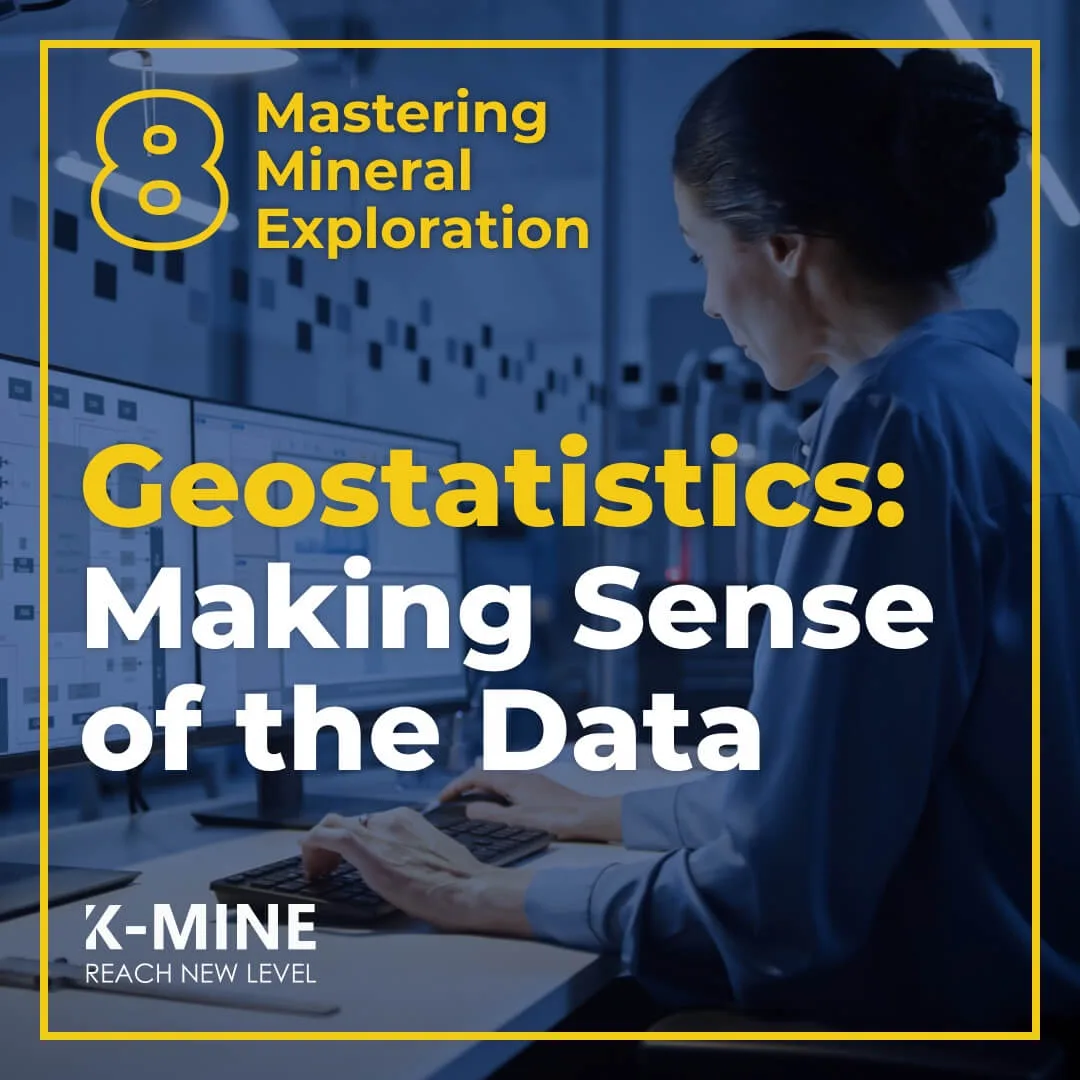
Content
- What is Geostatistics?
- The Importance of Geostatistics in Mineral Exploration
- Key Concepts in Geostatistics
- Variograms – Capturing Spatial Relationships
- Kriging – Predicting with Precision
- Other Statistical Models in Geostatistics
- Software and Geostatistics
- Challenges and Future Trends in Geostatistics
- Conclusion
In the realm of mineral exploration, a treasure trove of data awaits the experienced geologist. It comes in many forms and from various sources – drilling samples, geochemical tests, geophysical surveys, and even satellite imagery. But the raw data, in all its complexity, needs to be deciphered, analyzed, and understood. This is where geostatistics becomes an indispensable tool in a geologist’s toolkit.
Geostatistics, a branch of statistics dedicated to analyzing and interpreting spatially related data, serves as the linchpin in converting abstract numbers into meaningful insights. It doesn’t just illuminate the data we have; it also helps predict what we don’t know, making it crucial in understanding and predicting the characteristics of mineral deposits.
Our journey in the vast landscape of mineral exploration is a complex one, filled with uncertainties. These uncertainties are due in part to the inherent variability in geological phenomena and the limited data we can realistically obtain. But through geostatistics, we can weave together the threads of disparate data points to create a coherent, comprehensive understanding of the subsurface. By grappling with this variability and giving us a handle on uncertainty, geostatistics becomes a lighthouse, guiding us through the intricacies of mineral exploration.
So, let’s embark on this exploration together, to learn about the role, methodologies, and implications of geostatistics in mineral exploration. It’s time to make sense of the data.
What is Geostatistics?
Geostatistics, as the name suggests, is the study of statistics applied to spatial or geospatial phenomena. It originated in the field of mining geology in the early 1960s, thanks to the pioneering work of French engineer Georges Matheron. His work was based on the study of spatial patterns of variability within mineral deposits, and this laid the foundation for what we now call geostatistics.
In essence, geostatistics is a collection of mathematical and statistical techniques used to analyze and interpret spatial relationships within geological data. In mineral exploration, it allows us to analyze and interpret the geospatial data that we collect, whether it be from core samples, geochemical analyses, or geophysical surveys. It takes into account not only the inherent variability of geological phenomena but also their spatial continuity.
Geostatistics plays a vital role in quantifying the uncertainty of mineral resources and ore reserves. It allows us to understand spatial relationships and predict values at unsampled locations – an ability particularly useful when characterizing mineral deposits.
Remember, the underground world is not always as it seems on the surface. Outcrops or drill holes provide a limited view, just as looking through a straw would only show a tiny part of the landscape. Geostatistics provides us with the tools to fill in these gaps and build a comprehensive understanding of the deposit. It helps us to turn the chaos of raw data into an intelligible map, one that guides us in the quest for valuable mineral resources.
The Importance of Geostatistics in Mineral Exploration
Navigating through the complexities of mineral deposits can be likened to solving a multidimensional puzzle. A puzzle that not only demands intricate understanding of the rocks’ physical and chemical properties but also their spatial distribution – how these properties change from one location to another and what patterns they form. This is where the importance of geostatistics in mineral exploration becomes truly paramount.
One of the key goals in mineral exploration is to minimize uncertainty and risk. After all, the decision to mine is a high-stakes endeavor with massive financial implications. The more accurately we can predict what lies beneath the surface, the more confident we can be in our investment decisions.
Geostatistics enables us to decipher the language of the Earth. It allows us to create robust statistical models that characterize the geospatial distribution of mineral deposits, interpret the patterns within our data, and make predictions about areas we have yet to sample. This enhanced understanding can significantly reduce the geological risk associated with mining projects.
For instance, let’s consider a scenario where we’re trying to assess the grade variability within a gold deposit. Using geostatistics, we can predict the gold grade at unsampled locations based on the samples we have. We can also quantify the uncertainty associated with these predictions. These insights can significantly influence the mining strategy, guiding where to dig, how to sequence the mining operation, and even whether the project is economically viable.
In summary, the application of geostatistics in mineral exploration is a powerful tool for making sense of the data we collect. It helps us to understand the complexities of mineral deposits, reduces the uncertainties inherent in exploration, and ultimately guides more informed, risk-mitigated decision making.
Key Concepts in Geostatistics
Peeling back the layers of geostatistics, we encounter a few foundational concepts that are central to the discipline. These concepts, such as spatial autocorrelation, variograms, and kriging, form the bedrock upon which we build our understanding of geospatial data in mineral exploration.
Let’s start with spatial autocorrelation. This concept is based on Tobler’s First Law of Geography which states that “everything is related to everything else, but near things are more related than distant things.” Spatial autocorrelation refers to the degree of interdependence between spatial data values. In mineral exploration, this implies that the concentration of a mineral in one location can influence its concentration at a nearby location. Understanding spatial autocorrelation is crucial in constructing accurate models of mineral deposits.
Next up are variograms. A variogram is a graphical tool used in geostatistics to quantify the spatial autocorrelation between sampling points. It plots the variance of pairs of data points against the distance separating those points. A variogram helps geologists understand how spatial variability changes with distance, which is essential when predicting the mineral grade at unsampled locations.
Finally, we have kriging – a statistical estimation technique named after South African mining engineer Danie G. Krige. Kriging uses the spatial autocorrelation of data, as captured by the variogram, to make predictions about unsampled locations. It provides not only an estimate but also a measure of the uncertainty associated with that estimate. In mineral exploration, kriging can be used to generate mineral resource estimates and guide drilling campaigns.
Together, these concepts help to decode the spatial complexities within our data, enabling us to construct comprehensive and reliable geological models. From understanding the patterns of mineral distribution to predicting the value of unexplored regions, these key geostatistical concepts play an indispensable role in mineral exploration.
Variograms – Capturing Spatial Relationships
Unraveling the intricacies of mineral deposits requires a solid understanding of spatial relationships, which is where variograms come into play. Acting as geostatistical power tools, variograms provide a quantitative measure of spatial relationships that form an integral part of understanding deposit structures.
A variogram is a plot that depicts the semi-variance between data pairs as a function of their spatial separation. Semi-variance is a measure of variability, and it increases with distance when the data values are spatially correlated. By quantifying this spatial relationship, variograms allow geologists to ascertain how quickly the predictability of mineral content decreases as the distance between sample points increases.
Let’s consider a practical example. Imagine we are investigating a potential gold deposit. We could create a variogram using the gold grades at various sample points. The resulting plot would show us the degree of similarity (or dissimilarity) between gold grades as we move away from each sample point. A steep variogram slope might suggest that gold grades change rapidly with distance, implying a complex and irregular deposit. Conversely, a flat variogram could indicate a more homogenous and predictable gold distribution.
Furthermore, variograms are crucial in identifying geological features like directionality or anisotropy, where mineral grades change differently along different directions. Such information is critical when determining the optimal direction for exploration drilling.
In essence, variograms are like lenses that bring the deposit’s spatial structure into focus. They help to illuminate the patterns hidden within the geospatial data and create a statistical foundation for more accurate mineral deposit predictions. This, in turn, increases the efficiency and efficacy of mineral exploration endeavors.
Kriging – Predicting with Precision
Kriging, named after the South African mining engineer Danie G. Krige, is an essential predictive tool in geostatistics. This advanced interpolation method is employed to estimate values at unknown locations based on the values at known locations, and it’s a critical component in creating reliable predictive models of mineral deposits.
The secret sauce of kriging lies in its capacity to weigh data according to their spatial relationships, determined by variograms, thereby offering estimates that minimize prediction error. Unlike other interpolation methods, kriging also provides an estimation variance, offering insight into the confidence or uncertainty associated with each estimate. This aspect is particularly valuable in mineral exploration, where understanding the degree of uncertainty can inform risk management in project decision-making.
Consider the exploration of a copper deposit. Using kriging, we could estimate copper grades in unsampled areas based on the known grades in sampled locations. The resulting predictions, along with their associated uncertainties, would help to construct a more precise picture of the copper deposit’s extent and quality.
However, kriging isn’t a one-size-fits-all tool, and several variants cater to different scenarios. Simple kriging assumes a known constant mean across the entire field, while ordinary kriging presumes a constant but unknown local mean.
Universal kriging takes it up another notch by incorporating a deterministic trend. Choosing the right form of kriging requires a thorough understanding of the underlying geology and the statistical properties of the data.
In the grand scheme of mineral exploration, kriging offers a robust method to turn spatial data into predictive models, which are vital in guiding further exploration efforts and eventual mine planning. This advanced geostatistical tool allows us to make the most of the available data, driving efficiency, and reducing uncertainty in the quest to unearth valuable mineral resources.
Other Statistical Models in Geostatistics
Geostatistics is a rich field, boasting an array of statistical models that go beyond variograms and kriging. Two such examples that play significant roles in mineral exploration are Sequential Gaussian Simulation (SGS) and Indicator Kriging.
Sequential Gaussian Simulation is a stochastic method that generates multiple equally probable spatial models that respect the statistical properties and spatial relationships within the data. In the realm of mineral exploration, these simulations can be used to model grade distributions, geological shapes, and even risk.
Unlike deterministic methods like kriging, which provide a single best estimate, SGS creates a suite of potential models, allowing us to explore the range of possible scenarios and gain insight into the uncertainty associated with our predictions. This approach can help identify high-risk areas that might require additional sampling or different strategic considerations.
Indicator Kriging, on the other hand, is an adaptation of the kriging methodology for categorical or binary data. It’s particularly useful when dealing with variables that exhibit a threshold effect, such as mineral grades that are economically viable versus those that are not.
Rather than estimating the variable itself, Indicator Kriging estimates the probability that the variable exceeds a certain threshold. This method is often employed in resource classification, where it aids in categorizing a deposit into inferred, indicated, and measured resources based on data quality and the degree of geological confidence.
Understanding and selecting the right statistical model for a given scenario is crucial. The chosen method can significantly impact the resulting predictions and, consequently, the decisions made based on these predictions. While geostatistics can be complex, the rewards for correctly applying these tools are significant, enabling geologists to make more informed, data-driven decisions in their quest to unearth valuable resources.
Software and Geostatistics
Geostatistics, while powerful, can be a complex discipline. The computational heavy lifting involved in implementing and running these statistical models can make it a daunting prospect for many geologists. Thankfully, modern software tools, such as K-MINE, are designed to simplify this process, enabling geologists to harness the power of geostatistics without needing to be statisticians themselves.
K-MINE, as an integrated system designed for geology, surveying, and mining, incorporates a wide array of geostatistical methods right out of the box. These range from fundamental tools like variogram modelling and kriging, to more advanced stochastic methods such as Sequential Gaussian Simulation.
One of the key benefits of using software like K-MINE in geostatistical analysis is the ability to visualize data in a user-friendly manner. Geostatistical models can produce large volumes of data that are difficult to interpret in raw form. However, K-MINE, with its robust data visualization capabilities, helps in bringing this data to life. Geologists can create and interact with 3D models of mineral deposits, variograms, and more. This greatly aids in understanding spatial relationships, estimating grades, and planning exploration or extraction activities.
Moreover, the software offers geologists the flexibility to experiment with different parameters, enabling them to explore various scenarios and assess the associated risks. This flexibility, coupled with comprehensive visualization capabilities, assists in transforming intricate geostatistical data into digestible, actionable insights.
In the rapidly evolving world of mineral exploration, having the right tools is as important as having the right knowledge. Software solutions like K-MINE are proving to be an indispensable ally in this quest, bridging the gap between complex geostatistics and practical geological applications.
Challenges and Future Trends in Geostatistics
While geostatistics has undeniably revolutionized the field of mineral exploration, like any scientific discipline, it’s not without its challenges. Perhaps the most significant among them is the intrinsic complexity of geostatistical models. A sound understanding of both the underlying statistical principles and the geological context is vital to properly apply these models and interpret their results. Furthermore, geostatistical analysis is as good as the data it relies upon. Data quality, accuracy, and completeness all play critical roles in the reliability of geostatistical predictions.
Another challenge lies in the variability and uncertainty inherent to mineral deposits. Mineral grades and distributions are often subject to abrupt changes, which can be difficult to predict with traditional geostatistical methods.
However, as we look to the future, emerging technologies and trends hold the potential to address some of these challenges. Machine learning and artificial intelligence are already making inroads into mineral exploration and hold great promise for the future of geostatistics. These technologies can potentially help in recognizing patterns and making predictions in ways that may be difficult, if not impossible, with traditional statistical methods.
Additionally, the integration of geostatistics with other forms of data analysis and interpretation, such as 3D geological modelling and geophysical inversion, may also aid in the creation of more comprehensive and accurate models of mineral deposits.
The field of geostatistics is a dynamic one, with constant advancements and improvements being made. By staying abreast of these developments and leveraging these cutting-edge tools and methodologies, geologists can continue to unlock the full potential of geostatistical analysis in their quest to uncover the Earth’s mineral wealth.
Conclusion
The world of mineral exploration is inherently complex and full of uncertainties. Geostatistics stands as a robust pillar, allowing us to interpret, analyze, and make sense of geospatial data, thereby aiding us in reducing these uncertainties. From understanding basic concepts like spatial autocorrelation, delving into the depths of variograms and kriging, to employing advanced statistical models, we’ve taken a detailed tour of how geostatistics serves as an indispensable tool in the realm of mineral exploration.
We’ve also touched upon the challenges that this discipline faces, from data quality issues to the complex nature of mineral deposits. However, we’ve seen that the future holds significant promise. As we move forward, advances in technology, particularly AI and machine learning, promise to take geostatistics to new heights, enhancing our ability to extract actionable insights from geospatial data.
Mineral exploration is a journey of discovery that is paved with data. Transforming this data into knowledge requires tools like geostatistics. So, as we continue to push the boundaries of what’s possible in mineral exploration, our understanding and application of geostatistics will undoubtedly evolve alongside.
Join us in our next article as we venture further into the intricacies of mineral exploration, where we will be delving into ‘Reserve Estimation: The Final Frontier in Mineral Exploration’. Stay tuned!



 Back
Back